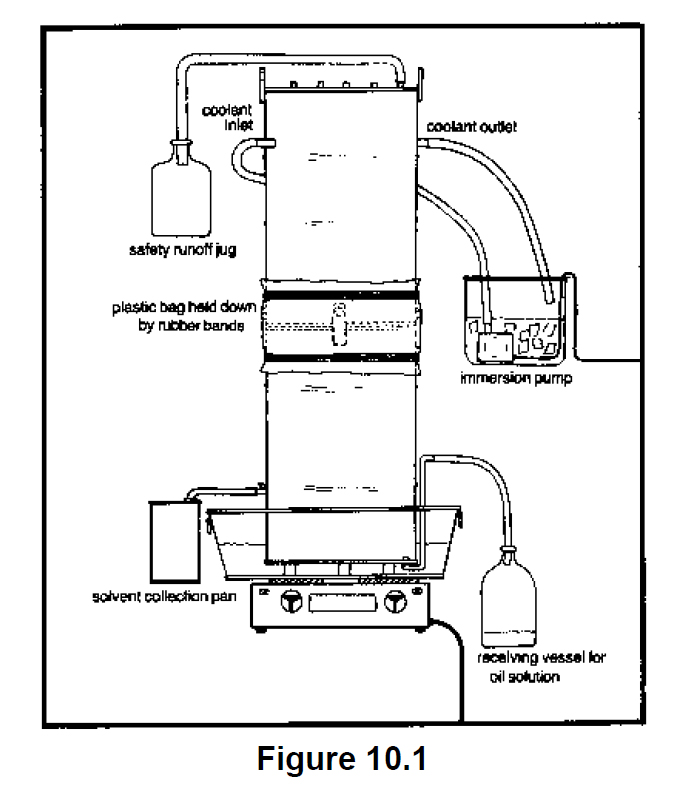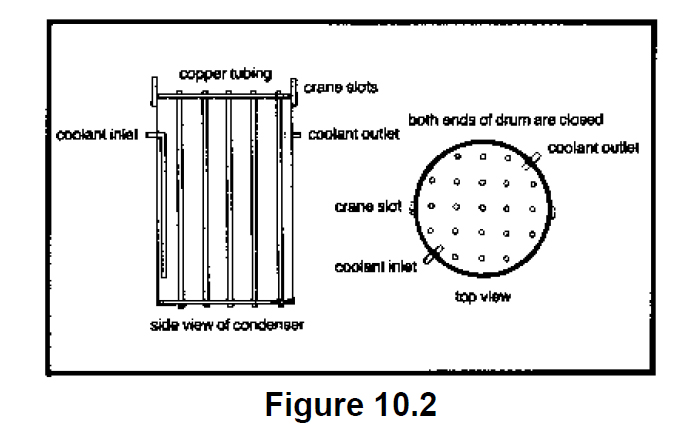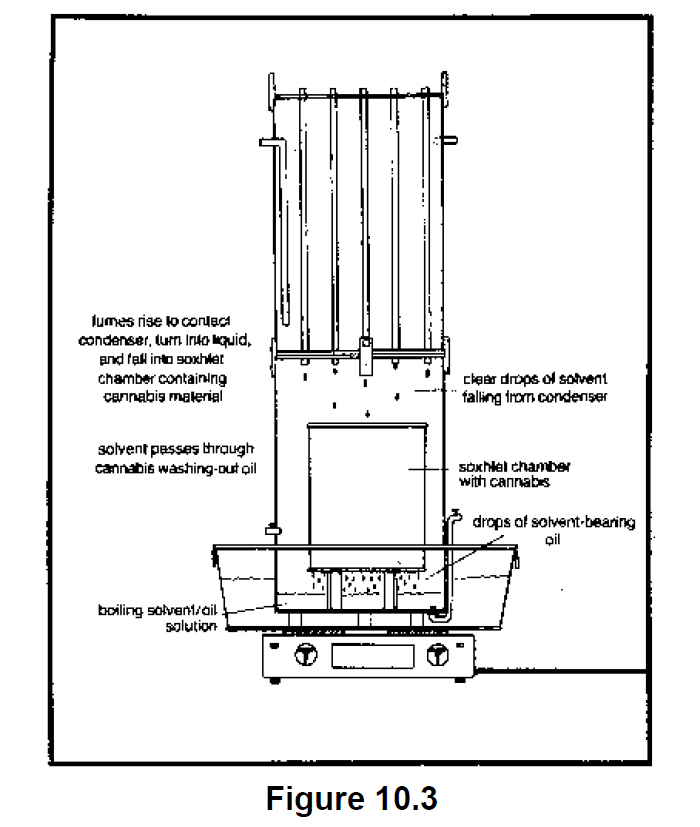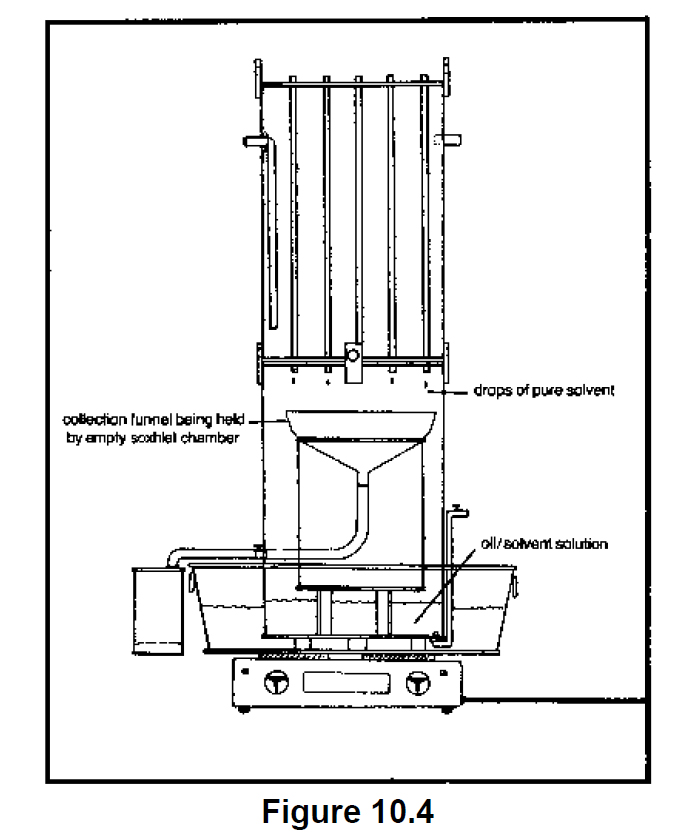
Cannabis Alchemy
by D.Gold
High-Volume Extraction Method
The high potency and small volume of cannabis oil, in conjunction with antimarijuana laws in many states, has added up to high potential profits for smugglers of the oil and new problems for law enforcement agencies. In the United States, the Drug Enforcement Administration (Drug Enforcement, 1973) has commented on the new problem (see Michael Starks’ Marijuana Potency for an excerpt) and describes various devices they have seized. The plight of the DEA is reminiscent of the traditional moonshiner revenuer chase, and no discussion of cannabis alchemy would be complete without a look at the hardware and methods of the large-scale operation. The apparatus is constructed using two 55-gallon oil drums and equipment purchased from a hardware or surplus store, with which very large amounts of marijuana or hashish may be extracted and processed.

The apparatus is appropriately designed to meet the unique problems inherent in high-volume extraction and contains the necessary safety features to prevent mishaps with flammable solvents. The apparatus may be used to perform all the operations: refluxing, soxhleting, distilling, and collecting of solvents. Even though the apparatus has many safety features (pressure relief valves and construction design which would prevent a minor mishap from being disastrous), the large volumes of inflammable solvents used pose a serious fire hazard. Even if the possibility of an accident is remote, the large scale and violence of a major accident warrant all possible caution. Such a device is always tended during operation, and measures to shut it down are ready at all times. The solvent and cannabis solutions and mixtures are heated, via the tub of boiling water, in the lower oil drum. The upper drum acts as a giant condenser; it is filled with circulating ice water so that when the solvent fumes contact its surfaces, they recondense into liquid and fall back into the lower drum. The tops of the tubes, except for one which acts as a safety pressure relief valve, are closed with rubber stoppers. The solvent fumes condense inside these tubes, as they do on contact with the bottom surface of the condenser drum. The bottom surface of the condenser drum acts as the top surface of the lower boiling drum. Construction of the condenser drum begins by marking corresponding four-inch grids on the top and bottom surfaces of the oil drum. A hole is drilled at each point where the lines intersect and pieces of one inch copper tubing are run through the drum lengthwise. Each tube protrudes about one inch from the surface on both top and bottom. A watertight seal is soldered or welded around the outside of each tube where it passes through the surface.

Inlet and outlet fittings for the circulating ice water coolant are fitted to the top of the barrel. Two metal straps are attached to the top of the drum on opposing sides. The straps have large holes through which a chain is run. This allows the apparatus to be lifted with a small overhead crane. The removal of the top is the first step in the preparation of the lower oil drum. Sturdy legs are attached to the bottom of the drum for maintaining a space between the bottom of the drum and the bottom of the boiling water bath into which the drum is set. A copper drain tube with an on/off valve is attached to the bottom of the drum, enabling the solvent/cannabis solution to be drained by siphon. Four metal straps are attached to the top of the drum. These protrude above the top of the drum and are used to secure the upper drum to the lower. A fitting with an on/off valve is run through the side of the drum approximately halfway between the top and bottom.

During extraction, a chamber containing marijuana or hashish is placed between the drops of recondensed solvent falling from the condenser and the boiling solvent solution. The distilled, recondensed solvent runs through the cannabis material, washing out the oil. The soxhlet chamber is removed and many holes are punctured in the bottom with a nail. A hole is cut in the side of the drum at a point slightly higher than the on/off valve in the side of the lower drum. A plate is fashioned to close the hole when necessary. Solvent may be removed from a solution and collected by catching the recondensed drops of solvent in a funnel as they fall from the copper tubes. A tube leading from the funnel through the hole in the soxhlet chamber to the on/off valve in the side of the lower oil drum transfers the pure distilled solvent to the outside of the apparatus, where it is collected in a metal can.

The following additional equipment is used during operation:
- A large, deep tub, at least twice the diameter of the oil drums, for a boiling water bath.
- An immersion pump and a large pail for ice and water.
- A long piece of hose which runs from the top of one of the copper tubes to an empty jug.
- Rubber stoppers for closing the tops of the remaining copper tubes.
- Large, thick polyethylene trash bags and several giant rubber bands, fashioned out of inner tubes, to fit around the drums.
- A large funnel of nearly the same diameter as the large drum and a piece of tubing to connect the spout of the funnel to the on/off valve on the side of the lower drum.
- An overhead chain winch or locking block and tackle for lifting the components.
- Three heavy-duty sparkless electric hotplates.
The principles of each operation parallel those in the basic extraction method using kitchen and hardware equipment.
The marijuana or hashish is prepared for refluxing by grinding it to a fine powder. The lower drum is filled to approximately one-third full with the powdered cannabis material and solvent is added to half fill the lower drum. The valve on the side of the drum is closed. The funnel and soxhlet chamber are not yet used. The upper drum is secured to the lower and the crack between the two oil drums is sealed in the following manner: a large trash bag, with the bottom cut out, is slipped over the apparatus and positioned at the joining of the drums. Inner-tube rubber bands secure the plastic to the drums both above and below the joining. This arrangement acts as a safety valve. Should any pressure build inside the apparatus, the plastic will puff out.
The entire apparatus is placed in the tub, which is resting on the three electric hotplates. An immersion pump in a tub of ice and water supplies coolant, which is pumped through the condenser drum. Rubber stoppers are used to seal the tops of all the copper tubes except one. A long piece of garden hose is attached to the tube; the hose runs into a large jug which is set in a place which is safe from flame or electrical spark. As long as ice water is being circulated through the condenser drum, no fumes or liquid will appear in the jug. If any fumes or liquid are given off from the hose, the boiling water is removed from the bath, and ice and water are immediately added. The condenser and coolant system are then checked.
The electric hotplates are turned on and allowed to heat the water bath to boiling temperature. This, in turn, heats the mixture of solvent and powdered cannabis material. The solvent fumes rise to where they contact the copper tubes and bottom surface of the condenser barrel, then recondense into liquid and fall back into the boiling mixture.
The mixture is refluxed for three hours, then the hotplates are turned off and disconnected. The boiling water is removed from the tub. The tub is refilled with ice and water, and allowed to stand for at least one half hour. After the apparatus has cooled sufficiently, the oil-saturated solvent is removed using a siphon pump to draw the mixture through the drain tube. After removing all the solvent and draining the condenser, the drums are opened, and all the cannabis material is scooped out and stored in a closed drum.
The cannabis oil/solvent mixture is replaced in the lower drum and assembled for distillation and collection of the solvent. The funnel, which is held by the empty soxhlet chamber, collects the recondensed drops of pure solvent as they fall from the tubes. The liquid runs through a hose to the fitting on the side of the drum. Another hose on the outside takes the solvent to a
receiving barrel, where it is collected. When all the solvent is evaporated, a heavy film of oil coats the bottom of the lower drum. This is redissolved in a small amount of solvent and the mixture is removed from the drum. The mixture is stored in an unbreakable container.
The damp, powdered cannabis is replaced in the drum and the solvent just removed and collected is added. The apparatus is assembled and operated as before, then refluxing for three hours, draining and collecting the oil. The bottom of the soxhiet chamber is fitted with a filter paper and set in the lower drum. The chamber is filled with the powdered cannabis, and clean solvent is added to the cannabis until it is saturated and several inches of solvent, which have run through the cannabis material, are in the bottom of the drum. The apparatus is reassembled and the water in the bath is brought to a boil. The fumes of the solvent in the lower drum will rise, recondense to liquid in the copper tubes, and fall into and run through the cannabis, washing out the remaining cannabis oil. After several hours of soxhieting, all the oil will be dissolved in the solvent. The cannabis oil/solvent solution is distilled and collected as before. The oil remaining in the drum is dissolved in alcohol and removed. This solution is added to those collected after each
refluxing and combined in a large metal pot, the weight of which has been noted. The pot is placed in the dry bottom of the lower drum and the apparatus is assembled for distillation and collection of the solvent. The solvent is removed and the product remains in the pan. If further purification and chemical alteration is desired, the methods given earlier are applied.

